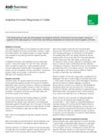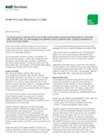Bovine Adaptive and Innate Immunity

- On This Page
- Overview
The adaptive and innate immune systems include humoral and cell-mediated immunity components. However, unlike the innate system, the adaptive system is antigen specific and provides a long-lasting protection against specific pathogens.
Adaptive Immunity
In adaptive immunity, cell-mediated immune responses involve T cells (CD4 Helper Th1 and Th2 cells, cytotoxic CD8, and gamma delta T cells) whereas humoral immune responses involve B cells. The adaptive immune system can be modulated, through vaccination, to become quicker, better and stronger in response to a specific pathogen with repeated exposure.
Innate Immunity
The innate system functions through a combination of natural defensive barriers - mainly skin, phagocytes and neutrophils, natural killer cells, cytokines, complement and antimicrobial peptides. The innate immune system is often referred to as an ancient defence system structured around cellular pattern recognition receptors (PRRs) that recognize pathogen-associated molecular patterns (PAMPs) found in prokaryotes but not eukaryotes.
Find out more in our articles introducing the two immune systems in the context of bovine immunology. They give an overview of the key cell types providing protection to the organism, the associated cytokine responses, and draw comparisons to mice and humans to illustrate the challenges facing researchers working on bovine immunology.
Find and order the antibodies required for research into the bovine interactive and innate immune systems in the table below.
Bovine Adaptive and Innate Immune System Antibodies
| Description | Target | Format | Clone | Applications | Citations | Code |
|---|




